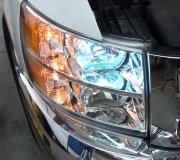The symptoms you described suggest multiple problems including the possibility of a charging system problem. Those are real easy to diagnose on your car and we'll discuss that next if necessary.
Actually, now that I think of it, everything you said could be due to a charging system problem. First, use a digital voltmeter to measure the battery voltage while the engine is running. It must be between 13.75 and 14.75 volts. If it is low, suspect the alternator but we need to do a few additional tests first to be sure. If the voltage is okay, or even a little high, the next thing is to have it professionally load-tested to see how much current the alternator can produce. Normal is somewhere around 90 amps. If all you can get is exactly one third of its rating, or about 30 amps, it has a bad diode. 30 amps is not enough to run the entire electrical system under all conditions and the battery will have to make up the difference until it slowly runs down. Also, "ripple" voltage will be high. That is the variation in the voltage, and the voltage regulator will respond to those changes and can result in flickering lights.
The additional potential clue is the head lights will not flicker when the engine is not running. If they do, that rules out an alternator problem.
The store that sold you the battery should be able to test the alternator, and they'll often do that for free. The test only takes a few seconds. It takes longer than that to connect the equipment to the battery. Be sure they do the full load-test though. A lot of mechanics just measure the battery voltage like I told you to do, and assume everything is okay. That can tell you the charging system is working but it can't tell you if it's working properly.
Always have that load-test done on the car. Some people take the alternator off the engine and carry it into an auto parts store for testing. That doesn't test the whole system, and those test benches aren't strong enough to run alternators wide open. Here again, they can tell you it's working but not if it's working properly. Alternators and generators are very inefficient at low speeds so we have to raise engine speed during the test. Can't do that on a test bench. Alternators can easily draw between five and ten horsepower from the engine. Most test benches have one horsepower or smaller motors to run the alternators. That's not enough to allow the full-load test to take place.
Also observe if you see any other lights flicker at the same time the head lights do. For example, if the brake lights, tail lights, interior lights, and the radio display don't flicker, that points to a head light circuit problem. Typically that will get worse very quickly until the head lights don't turn on at all. THEN we'll have something to find that will be obvious when we do.
Wednesday, June 26th, 2013 AT 9:12 PM



